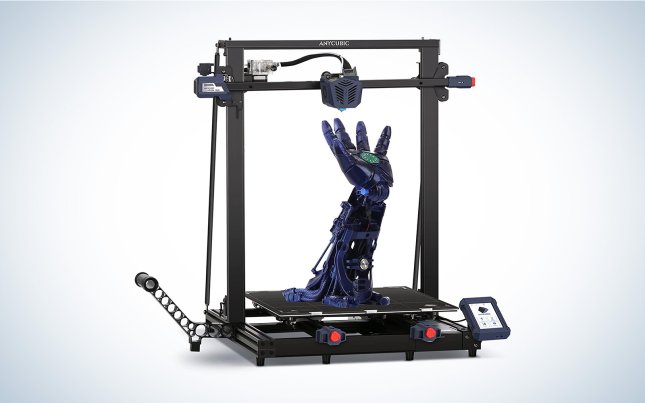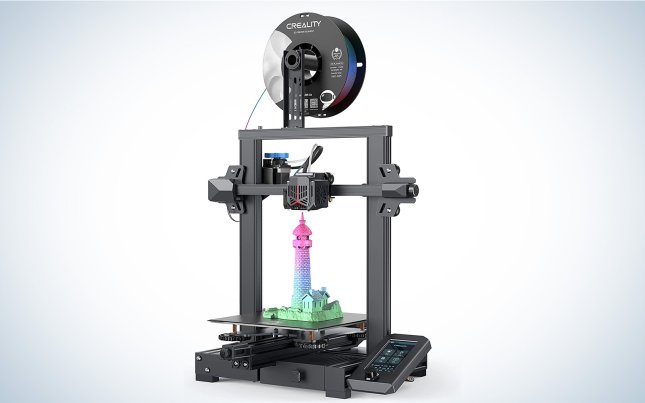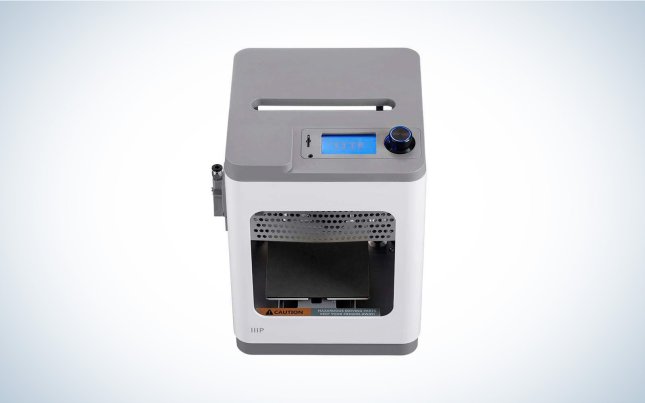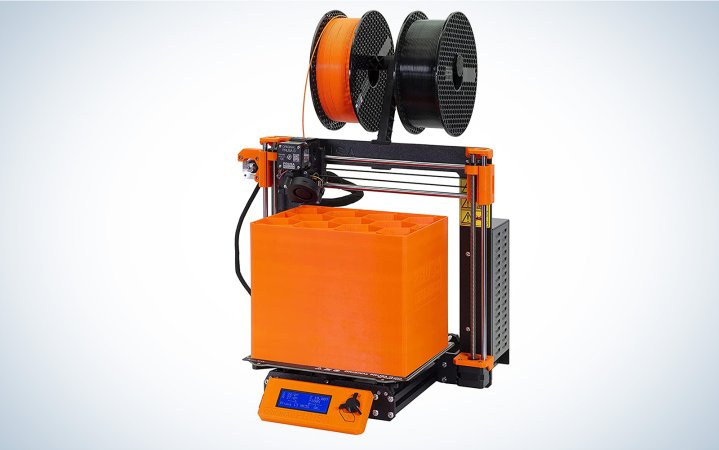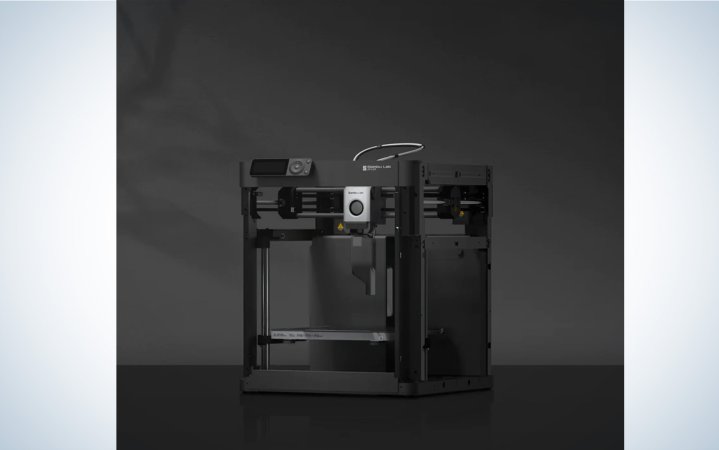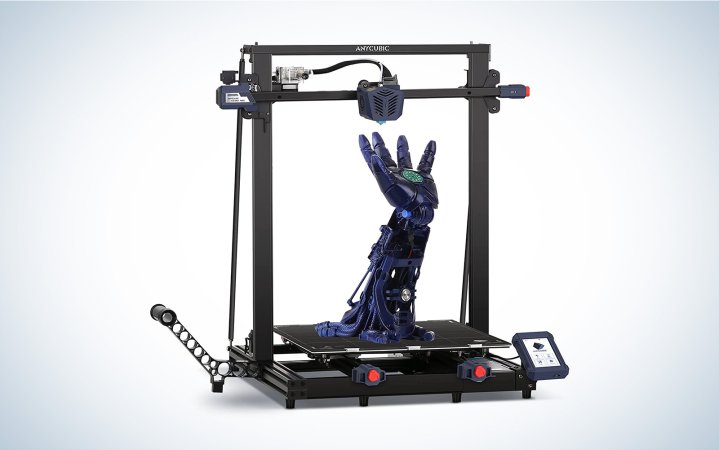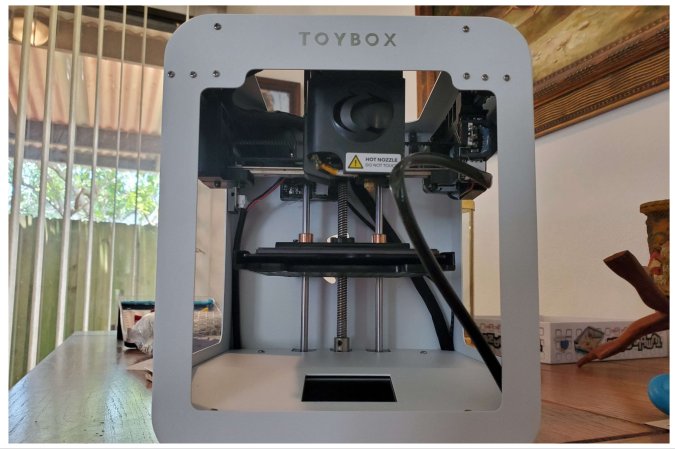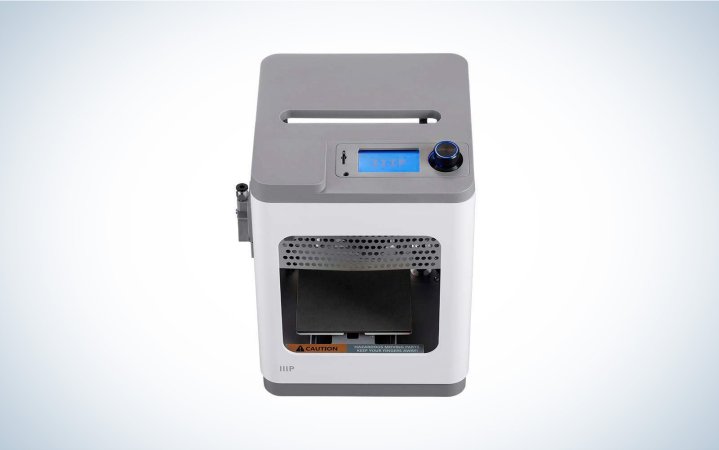We may earn revenue from the products available on this page and participate in affiliate programs. Learn more ›
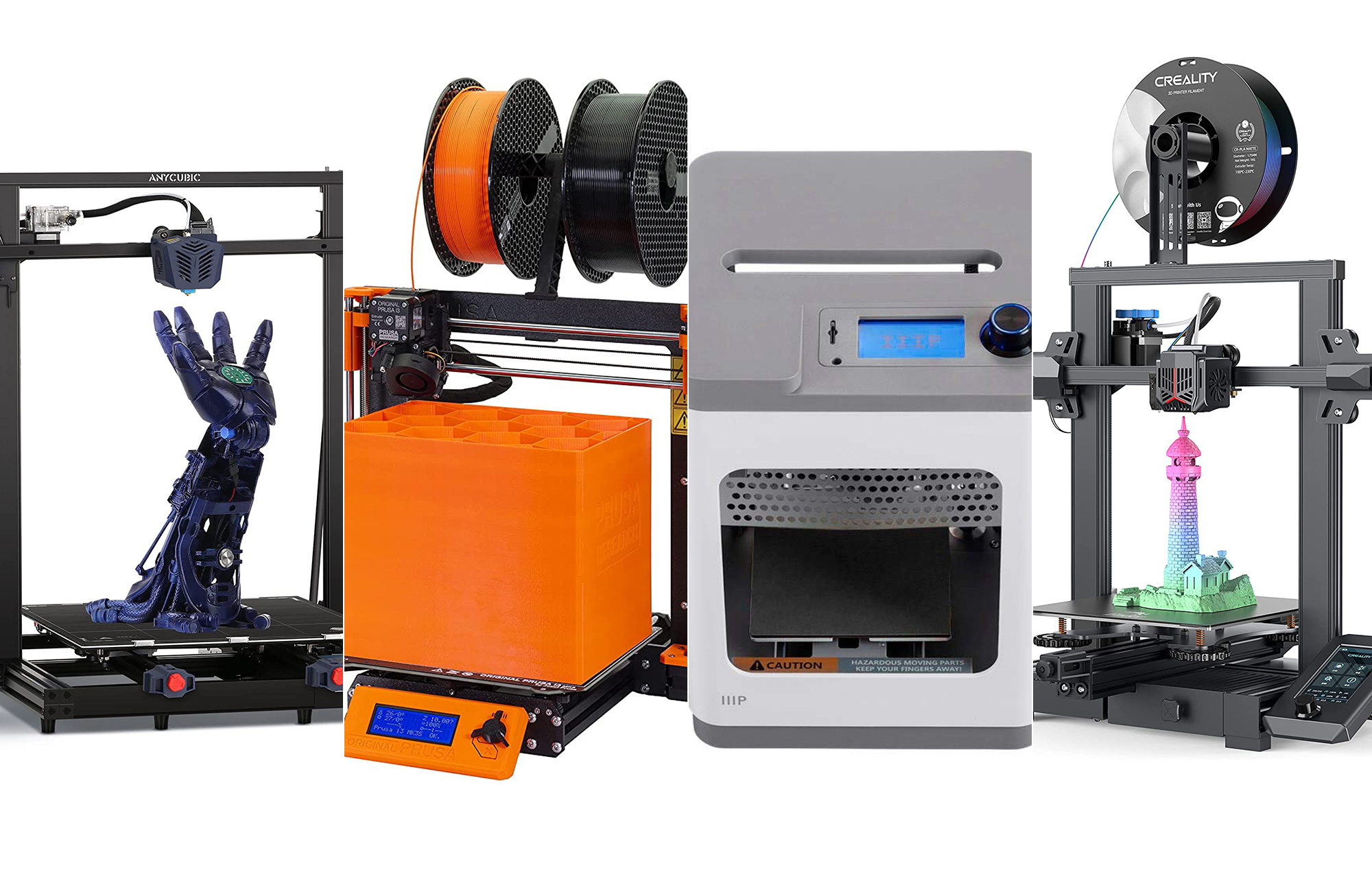
Even 3D printers for beginners can feel intimidating if you’re not familiar with the process. For instance, a recent 3D Printing Sentiment Index survey by Ultimaker revealed that 71 percent of professionals surveyed are aware of 3D printing. However, 29% of businesses that could potentially use 3D printing have no current familiarity with the technology. Nevertheless, engineers and entrepreneurs continue to use 3D printers in some very inventive ways: Astronauts plan to use a 3D printer on the International Space Station to print out elements of a human knee and engineers at Columbia University in New York have recently figured out how to replicate a seven-layer cheesecake. What’s encouraging is that in the last 12 years, 3D printers have also gotten more affordable.
But what exactly does a 3D printer do? Most consumer-grade 3D printers produce, or print, a three-dimensional object using a technology called “additive printing.” The process creates a three-dimensional object by building it layer upon layer using various materials, such as plastic or metal that adhere together during the process to eventually form the object. (The design of the object is based on a digital file, which is most often made using computer-aided design software, or CAD.) You’ll have to get over the initial learning curve, but watching that first print take shape can feel downright magical. The best 3D printers for beginners offer a simple setup, intuitive interfaces, and enough flexibility to grow with your skills.
- Best overall: Creality Ender 3 V2 Neo
- Best upgrade: Original Prusa i3 MK3S+
- Best for fast printing: Bambu Lab P1P
- Best for printing large objects: Anycubic Kobra Max
- Best kid-friendly: Toybox 3D Printer
- Best budget: Monoprice 140108 MP Cadet
How we chose the best 3D printers for beginners
In order to compile the list of 3D printers we recommend for this guide, we considered a number of factors. We prioritized intuitive models capable of more complex projects as your skills improve. Additionally, we made sure that the 3D printer came with compatible software, in order to develop and create the digital design yourself, which your print would be based on. Lastly, we considered price. Although you can spend as much as $2,000 to $10,000, or more, on professional- or commercial-grade 3D printers, we chose printers for this guide that were less than $1,000. Our specific picks are based on a mixture of personal experience, spec comparisons, user feedback, and editorial reviews.
The best 3D printers for beginners: Reviews & Recommendations
In the past 12 years, 3D printers have not just come down in price, but they’ve also become easier to use, for a number of reasons, most notably because of the involvement of the RepRap movement, which helped forge the way for the 3D-printing industry to create products that were more affordable, accessible, and reliant on open-source technology. The movement also helped standardize many aspects of 3D-printing technology, which benefits all consumers and businesses. While you’re at it, check out the best 3D printer filaments to put into your lovely new 3D printer.
Best overall: Creality Ender 3 V2 Neo
Best overall
Creality Ender 3 V2 Neo
Why it made the cut: It takes a little more setup than some other models, but it’s a near ideal mix of features and value for beginners.
Specs
- Materials supported: PLA, ABS, PETG,
- Print volume (HWD): 8.7 x 8.7 x 9.8 inches
- Connectivity: Micro USB, transflash memory card
- Dimensions (HWD): 17.2 x 16.7 x 18.6 inches
- Weight: 21.60 lbs.
Pros
- Inexpensive
- Its redesign improves the overall experience of it
- Faster than predecessor
Cons
- Learning curve can be steep for some
The new iteration of this Creality 3D printer includes some impressive enhancements to an already solid-performing 3D printer. Its CR-Touch feature, for instance, gathers the bed deviation data by touching multiple points in the bed and compensating for them accordingly, allowing for hassle-free bed leveling. It now comes with a full-metal Bowden extruder, which the company says makes for smooth feeding through the system.
Creality has also overhauled the UI: Its new 4.3-inch user interface is easier to read. It also has a new build plate: The PC spring steel magnetic build plate has good adhesion to the model, and it enables quick removal of the print with just a slight bend of the platform.
With prints measuring up to 8.7 x 8.7 x 9.8 inches, this model can easily churn out some of the most popular 3D-printed objects like fidget toys, replacement parts, and gaming miniatures.
While this isn’t the simplest model on the list (you’ll find some truly automated versions later on down the line), it isn’t prohibitively difficult to learn. Plus, it leaves room for users to sharpen their skills and improve their 3D printing process as they learn. If you’re a quick learner, too much automation can rapidly start to feel like more of a hindrance than a help.
Because Creality is one of the more popular brands in the space, it’s also very simple to find information, communities, and discussions online to help troubleshoot issues or clear up trouble spots.
Best upgrade: Original Prusa i3 MK3S+
Why it made the cut: This very versatile and reliable 3D printer is for those who are experienced in 3D printing and for those just learning
Specs
- Materials supported: PLA, ABS, PETG, ASA,
- Print volume (HWD): 9.8 x 8.3 x 8.3 inches
- Connectivity: USB, SD Card
- Dimensions (HWD): 19.6 x 21.6 x 15.7 inches
- Weight: 15.4 lbs.
Pros
- Produces excellent quality prints
- Very versatile
- Easy to Use
- Reliable
Cons
- A bit pricey
This well-built Prusa 3D printer is for just about any user, from those just getting started to those who’ve been 3D printing for years. That’s because the i3 MK3S+ delivers high-quality results for most typical home users, time after time. But it’s not just reliable. It also produces excellent quality prints with lots of detail, which is partly due to the 3D printer’s very solid build quality, which ensures those details will render properly. Also, the i3 MK3S+ has fewer errors during the printing process than other models in its class.
It’s not a perfect 3D printer, though. I had a couple of minor quibbles with the i3 MK3S+: For instance, it has a decent-sized 3.4-inch display, but the display is monochrome and not a touchscreen. (Other models have color touchscreens.) You can connect easily enough using an SD card to add your project to the machine. However, if you want to connect via Wi-Fi, you’ll need an accessory—a Raspberry Pi Zero W.
But those quibbles aside, it’s an excellent performing 3D printer, overall. For instance, it’s compatible with Ultimaker Cura, an open-source slicing application for 3D printers, as well as Prusa’s own software, PrusaSlicer. What’s also nice about this model is you have the option to automatically calibrate it or use the Mesh Bed Leveling process to compensate for microscopic imperfections of the print sheet. Plus, it prints pretty quietly, so it won’t disturb others around you.
Best for fast printing: Bambu Lab P1P
Bambu Lab P1P
Why it made the cut: It has very fast printing speed without reducing print quality.
Specs
- Materials supported: PLA, ABS, PETG
- Print volume (HWD): 10 x 10 x 10 inches
- Connectivity: Wi-Fi, Bluetooth, SD Card
- Dimensions (HWD): 15.2 x 15.3 x 18 inches
- Weight: 21.3 lbs.
Pros
- Very fast printing speed
- Excellent print quality
- Easy to set up
- Can print in multiple colors
Cons
- Pricey
- A bit noisy
While this printer is pricier than the rest of the models on this list, it could save you considerable time. It clocks in at a little more than 8 times the speed of many consumer 3D printers. While most 3D printers produce PLA objects at a speed of 60mm/s (different materials will quicken or slow down the speed), the maximum speed of the Lab P1P’s toolhead is 500 mm/s, according to the manufacturer. But what’s also important to note is that even though this model has a much faster printing speed, the quality of the 3D printing isn’t affected. Such an increase in speed can be incredibly important if you’re using the Lab P1P for a small business. Of course, it’s also important no matter how you use it since no one really likes to waste time waiting around for 3D prints.
But it’s not just a 3D printer that prints fast. It’s also very capable, with a number of advanced features, including the ability to print in different colors, vibration compensation, and a camera. It also comes with Bambu Lab’s Automatic Material System (AMS), which communicates with the toolhead to ensure smooth filament feeding.
That fast print speed also comes with a relatively large maximum print size. So, if you’re trying to print that Iron Man helmet for your massive noggin, this could be your savior.
Best for printing larger objects: Anycubic Kobra Max
Anycubic Kobra Max
Why it made the cut: This model has great print volume so you can produce larger scale objects than what most consumer-grade 3D printers can create.
Specs
- Materials supported: PLA, ABS, PETG, TPU
- Print volume (HWD): 17.7 x 15.7 x 15.7 inches
- Connectivity: MicroSD card
- Dimensions (HWD): 28.4 x 28.2 x 26.2 inches
- Weight: 43 lbs.
Pros
- Its large size lets you print larger scale projects
- Includes automated features, like its 25-point auto leveling function
Cons
- Projects take longer to print
- The unit is large and heavy
If you need to produce projects that are somewhat larger than your average-sized 3D printer can produce, you’ll want to check out this Anycubic model. In fact, its build volume is 17.7 x 15.7 x 15.7 in., which is significantly larger than most models in its class. However, one of the downsides of the larger space is that it takes longer to print your items. It also requires more work for calibrating the larger printing field and of course larger prints require more filament.
The 3D printer also comes packed with other useful features: it has a self-developed Anycubic LeviQ leveling function, which uses the printer’s 25-point smart and precise calibration system in order to compensate for the heated bed unevenness automatically. That means, according to the company, leveling and printing can be completed with just the press of a button.
Best kid-friendly: Toybox 3D Printer
Why it made the cut: Using this printer is very intuitive, and common sense will guide you through nearly every interaction.
Specs
- Materials supported: PLA
- Print volume (HWD): 7 x 8 x 9 cm
- Connectivity: WiFi, web browsing, app
- Dimensions: 7.4 x 7.4 x 9.05 inches
- Weight: 15.21 lbs.
Pros
- Most toys just work as printed
- App provides plenty to print and do, giving you options to make predesigned toys as well as easily design your own
- Access—with paid subscription—to third-party intellectual property
Cons
- Could use slightly more documentation, especially during initial setup
- Not all “create” tab toys worked perfectly
Per Toybox themselves, this 3D printer was built to be used by children, thanks to its bevy of one-touch buttons. You, as the parent/guardian/cool babysitter, should provide some supervision, but assistance isn’t necessarily needed. There’s no need to adjust the removable print bed, loading the filament is uncomplicated, and you don’t need to use a knife to remove prints. There’s also a coordinating app for iOS and Android that lets you find things to print and make your own creations. The sense of joy, wonder, and discovery as you go through the printer and app cannot be understated—cute little messages on the bottom of boxes, playful sounds during printing, usage of your own images to make certain toys, and more. Read our full review of the Toybox 3D printer.
Best budget: Monoprice MP Cadet
Why it made the cut: If you’re on a budget, this small model should fit the bill.
Specs
- Materials supported: PLA, PLA Pro
- Print volume (HWD): 3.9 x 4.1 x 3.9 inches
- Connectivity: USB, Wi-Fi, microSD card
- Dimensions: 8.3 x 8.3 x 11.4 inches
- Weight: 6.6 lbs.
Pros
- Small, compact, and lightweight
- Quick set up time
- Comes with auto leveling feature
Cons
- Small print volume
- Not as versatile as other models
Although there are plenty of 3D models that you pay a lot of money for, there are also a decent selection of 3D printers that are inexpensive, like this model from Monoprice, which makes it a great model for beginners and students. If you just want to start printing without diving into the process, this is a fast, easy option.
Despite its small size, though, it’s a solid performer: It can print relatively quickly. It’s also compatible with Ultimaker Cura, an open source slicing application for 3D printers, as well as Wiibuilder softare. Most of all, this printer delivers decent quality prints consistently. However, it’s not as versatile as some other, more feature-packed entry-level 3D printers.
With that low price, of course, expect a few drawbacks. The primary limitation here is the print size, which tops out around four inches on each axis. At just 6.6 pounds for the whole printer, though, this is the most portable model on our list.
What to consider when shopping for the best 3D printer for your needs
Part of the reason that 3D printers come in all different sizes, with vastly different feature sets, and an even great variety of price points, is that they have many disparate uses. For example, a designer might use it for creating a prototype, while an educator might develop a print to replicate an artifact to use in his history class. An artist might use a 3D printer to explore the potential of working in a new medium. But that’s just the tip of the iceberg. That’s why you need to take some time to consider the following features and capabilities before you buy your 3D printer.
Explore methods of 3D printing
There are a number of different processes that can be used in 3D printing. But today, the most commonly used method on consumer 3D printers is fused deposition modeling (FDM)—and all the 3D printers in this review use FDM technology. An FDM printer sends a filament of plastic (most often from a spool within the printer) through a small, heated nozzle, which then precisely lays down the thin layers of plastic on the surface of the base in order to construct the object. (In the 3D printer industry, FDM is also referred to as “fused filament fabrication”, or “FFF.”) An FDM 3D printer is pretty flexible, but if you’re looking for different results, you’ll want to research some of the other processes, such as stereolithography (SLA), which uses a resin-based method to print, or other methods.
Learn about 3D printing materials
It’s important to learn what materials you can use with your 3D printer: The filaments used in FDM 3D printers can be made of different types of material, too. Two of the most popular are polylactic acid (PLA) and acrylonitrile butadiene styrene (ABD), but there are others you can use. You can buy spools of replacement filament, but just be sure both the material and its size is compatible with your model. Most 3D printers print in just one color, but there are select models that have dual extruders, so you can print with two or more colors. Adding colors adds complexity, however, so that’s out of the scope for beginner skills.
Analyze your 3D printing needs
When it comes to 3D printers, you’ll also want to closely examine and evaluate the features, specifications, and capabilities you think you’ll need. For example, if you’re looking to print objects that are a bit larger, you’ll want to go with a model with a larger print volume that can handle larger prints. Or maybe you’re looking to produce a lot of objects quickly. Then pay close attention to the printer’s speed. Additionally, look to make sure it has the connectivity options, like Wi-Fi, that allow you to work in the manner you’re expecting.
There are other considerations you’ll want to consider, as well:
- What is the top resolution on your 3D printer? Resolution is measured in microns (a lower number is more detailed), with the default on many printers being 200 microns. However, some can print at 100 or 50 microns.
- Is it an open frame or close frame? 3D printers that are closed are safer, but open frame 3D printers are generally larger in size.
- What’s the size and the quality of the print bed? Having a good quality surface to work on is crucial since the first of your print depends upon a sturdy print bed to build the rest of the object.
- Are there any automated features? More and more 3D printers are including automated features, such as auto leveling the print bed, in order to speed up the process and to make the 3D printer easier to use.
- Are you interested in designing your 3D print yourself? If so, then you’ll need software, which is known as a “slicer” to create it. Some popular choices are PrusaSlicer, from Prucer, and Cura, from Ultimaker.
FAQs
Although you can still find 3D printers that are very pricey, those models are generally targeted at commercial markets. By and large, most 3D printers for home use have come down in price and you can find some very capable models for less than $1,000, even as low as $200. But in order to get a clearer picture of what your cost of ownership of the 3D printer will be, you’ll want to factor in how you’ll actually be using it. You’ll want to assess how much you’ll be printing, which means you’ll also need to find out the price of replacement spools of filament, or other additional materials for your 3D printer.
Today, 3D printers are used in many different industries across the globe, including healthcare, automotive, construction, manufacturing, the food industry, education, as well as in the production of different types of consumer products. At home, 3D printers can produce a variety of hardware items, like hooks, hangers, coasters, clips, various types of desk organizers, etc.
While the 3D printing industry as a whole has taken steps to make consumer-grade 3D printers safer for everyone using them, some health experts still express concern. For example, the Center for Disease Control and Prevention’s website says, “3D printing hazards vary depending on the type of printer and materials used.” It also points out that some methods used in 3D printing can cause you to breathe in harmful materials: “3D printing can release particulates and other harmful chemicals into the air.” Some materials can also be harmful if they come into contact with the skin—”metal powders, solvents and other chemicals.” And some materials can also be flammable or combustible. For more, see the CDC’s “3D Printing Safety at Work” webpage.
Final thoughts when buying the best 3D printer
- Best overall: Creality Ender 3 V2 Neo
- Best upgrade: Original Prusa i3 MK3S+
- Best for fast printing: Bambu Lab P1P
- Best for printing large objects: Anycubic Kobra Max
- Best budget: Monoprice 140108 MP Cadet
Some scientists and environmentalists have long considered 3D printers a “greener choice.” However, like conventional inkjet and laser printers, 3D printers do produce waste, mainly due to the various processes used in printing 3D objects, which are most often plastic. And adding more plastic into the environment is never a good thing. However, how sustainable your 3D printer is for the environment depends upon many factors, including the materials you use: For instance, PLA plastic is considered relatively easy to recycle and is only more biodegradable than other materials used for filaments.
Additionally, some experts in the 3D printer industry believe there are some fundamental aspects of 3D printing that should be beneficial for the earth and its environment. For example, one of the projects of the RepRap movement, which made 3D printers and technology more accessible over the past 10 years, was to create self-replicating 3D printers. In doing so, the group predicted that such self-replicating machines could benefit society overall by producing less waste in our global ecosystem.
